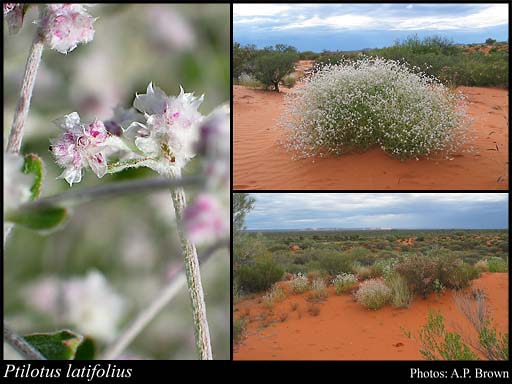- Reference
- Sturt, Narr.Exped.Cent.Austral. 2, App. :88 (1849)
- Conservation Code
- Not threatened
- Naturalised Status
- Native to Western Australia
- Name Status
- Current
Perennial, herb or shrub, to 0.7 m high. Fl. pink-white, May or Jul to Oct. Sand dunes, stony plains.

Scientific Description
Perennial herbs, stems several, more or less erect, persistently hairy or glabrescent, with nodose hairs. Leaves present, 5-80 mm long, 3-25 mm wide, glabrescent, with nodose hairs; basal rosette absent; cauline leaves alternate. Spikes white or pink, ovoid, hemispherical or spherical, clustered, with densely arranged flowers. Bracts (3.2-)3.5(-3.8) mm long, colourless, hairy, awned or mucronate, with an obscure midrib. Bracteoles 6-10 mm long, colourless, glabrous or hairy, awned or mucronate, with an obscure midrib. Outer tepals 4-7 mm long, entire. Inner tepals 3.8-6.5 mm long, glabrous within. Style (0.8-)1.2-1.4 mm long, straight, centrally fixed to ovary. Seeds 1-1.2 mm long, dull, brown. Distribution: Eremaean Botanical Region; IBRA regions: Dampierland.
Distribution
- IBRA Regions
- Carnarvon, Central Ranges, Dampierland, Gascoyne, Great Sandy Desert, Great Victoria Desert, Little Sandy Desert, Pilbara.
- IBRA Subregions
- Ashburton, Augustus, Cape Range, Carnegie, Fortescue, Hamersley, Mackay, Mann-Musgrave Block, Maralinga, Pindanland, Roebourne, Rudall, Trainor, Wooramel.
- IMCRA Regions
- Pilbara (nearshore).
- Local Government Areas (LGAs)
- Ashburton, Broome, Carnarvon, East Pilbara, Exmouth, Karratha, Laverton, Meekatharra, Ngaanyatjarraku, Upper Gascoyne, Wiluna.